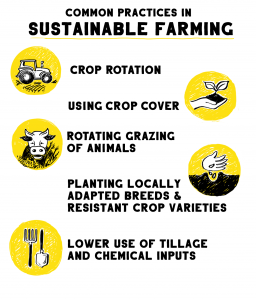An Everyday DNA blog article
Written by: Sarah Sharman, PhD, Science writer
Illustrated by: Cathleen Shaw
 Our world’s population is growing at an exponential rate. It is predicted that by 2050 there will be 9.7 billion people living on Earth. That is nearly two billion more people to feed, clothe, and house using our existing resources, most of which are limited. Combined with challenges like climate change, the agricultural field could be under immense strain in years to come.
Our world’s population is growing at an exponential rate. It is predicted that by 2050 there will be 9.7 billion people living on Earth. That is nearly two billion more people to feed, clothe, and house using our existing resources, most of which are limited. Combined with challenges like climate change, the agricultural field could be under immense strain in years to come.
Farmers will need to produce more food, feed and fiber than ever before to keep up with rising demand. Unfortunately, many of the new technologies and processes that farmers often employ to keep up with growing supply demand are harmful to our environment, society, and economy.
We must find new ways to feed a growing population in an equitable and healthy way, without harming our planet any further. Let’s learn about a growing movement that aims to sustain our ways of life on Earth while protecting Earth’s ability to meet our needs today and in the future.
What is sustainable agriculture?
A quick web search for the term ‘sustainable agriculture’ will bring up a variety of different definitions. At its core, sustainable agriculture (also referred to as sustainable farming) aims to produce food, feed, and fiber products to meet the needs of today, without sacrificing the needs and well-being of future generations.
The agricultural sector faces tremendous pressure from climate change, but it is also one of the biggest contributors to the same climate change threatening its livelihood. Large farms grow the same crops year after year, using chemicals and fertilizers that damage water, air, and soil. These practices deplete topsoil nutrients, contaminate groundwater, and reduce biodiversity. In addition, they use an abundance of fossil fuels for transportation and both tilling and applying chemicals to fields. Sustainable agriculture seeks to reduce the negative impact of farming on the environment by promoting farming practices that conserve our soil, water, wildlife habitat, and energy resources. 
Competition to meet supply demands unfairly favors large, industrial farms, leaving little room for the success of small and medium-sized family farms. Sustainable agriculture considers social responsibilities such as working and living conditions of farmers and workers, the needs of rural farming communities, and the health and safety of consumers both today and in the future. Practitioners of sustainable agriculture emphasize the fair treatment of farm workers and support food pricing that provides the farmer with a livable income while also making food equitable to all.
Making the switch to sustainable farming practices does not happen overnight. Farmers must phase out environmentally harmful and wasteful practices and embrace farming techniques that mimic natural processes. Sustainable farmers find ways to work with nature when raising crops and livestock by focusing on things like biodiversity, soil health, ecological pest management, and water conservation. Common practices in sustainable farming include crop rotation, the use of cover crops, rotational grazing of animals, planting locally adapted breeds and resistant varieties of crops, and lower use of tillage and chemical inputs.
How is biotechnology helping sustainable farming?
Farmers are not alone in the sustainability fight. It takes many other stakeholders to ensure the success and longevity of a sustainable farming system. Sustainable agriculture has benefited greatly from close relationships between farmers and scientists. The scientific community has made many impactful contributions to sustainable agriculture so that farmers can maximize productivity and profit while minimizing environmental damage. The application of biotechnology to agriculture can also help conserve biodiversity, reduce agriculture’s ecological footprint, help to mitigate climate change, and contribute to the alleviation of poverty and world hunger.
The HudsonAlpha Center for Plant Science and Sustainable Agriculture was created to serve as a reliable resource to farmers looking to transition to more sustainable farming practices. The Plant Center brings together the unique expertise of its five core members to create diverse ways to apply genomics to solve challenges in modern plant science and agriculture. The members are Jeremy Schmutz, Jane Grimwood, PhD, Kankshita Swaminathan, PhD, Josh Clevenger, PhD, and Alex Harkess, PhD.
The group discovers genomic solutions to challenges in the field by combining evolutionary and computational genomics, and applying cutting-edge technologies to transform and improve the plant or crop. Below are a few examples of how researchers at the Plant Center are contributing to sustainable agriculture.

Creating healthier and more productive crop varieties
All five Plant Center core members, along with collaborators from Auburn University’s departments of Crop, Soil and Environmental Sciences and Entomology and Plant Pathology, and Alabama A&M’s Winfred Thomas Agricultural Research Station, are working together to develop better agriculture seed varieties to produce healthier and more productive crops. The goal of the project is to use the power of genomics and plant breeding to introduce new, improved agricultural crops in Alabama.
Aflatoxins are a group of liver-damaging toxins that can contaminate agricultural crops like peanuts, tree nuts, maize, and grains. Clevenger and a team at Mars, Incorporated aim to create low-aflatoxin peanuts by addressing a related issue, drought stress. Clevenger and his team are using genomics and computational tools to identify genetic markers that give peanuts drought tolerance, which will eliminate stress conditions that activate aflatoxin production.

Reduced environmental impact
Schmutz, along with collaborators at Auburn University’s College of Agriculture, are working to accelerate efforts to breed a drought-tolerant peanut plant. HudsonAlpha researchers will use genome sequencing to determine DNA variants that distinguish the most drought-tolerant and susceptible peanut varieties. Drought-tolerant peanut plants would decrease the amount of water needed during a crop year, leading to a higher-yield harvest and a reduction in the use of water, a precious natural resource.
Swaminathan and Schmutz, along with collaborators from the University of Nebraska-Lincoln and Alabama A&M University, aim to reduce the amount of nitrogen that crops need to produce a maximum yield. Nitrogen plays an important role in the health and growth of plants, and farmers supplement naturally occurring nitrogen in the soil with nitrogen fertilizers which are expensive. Identifying and creating crops that use nitrogen more efficiently will make it possible to increase crop yield while reducing the environmental footprint and increasing farmer profits.

Sustainable grasses for biofuel production
The Department of Energy (DOE) designated switchgrass and Miscanthus promising candidates for biofuel, renewable fuel that is produced from the biomass of plants. Grimwood, Schmutz, and Swaminathan are part of a multinational team of researchers that have been studying the genome of these grasses for over a decade. Their goal is to create plants that can survive across a range of environments while still producing a large amount of biomass that can be turned into biofuel.
To learn more about the HudsonAlpha Center for Plant Science and Sustainable Agriculture, visit the website here.


